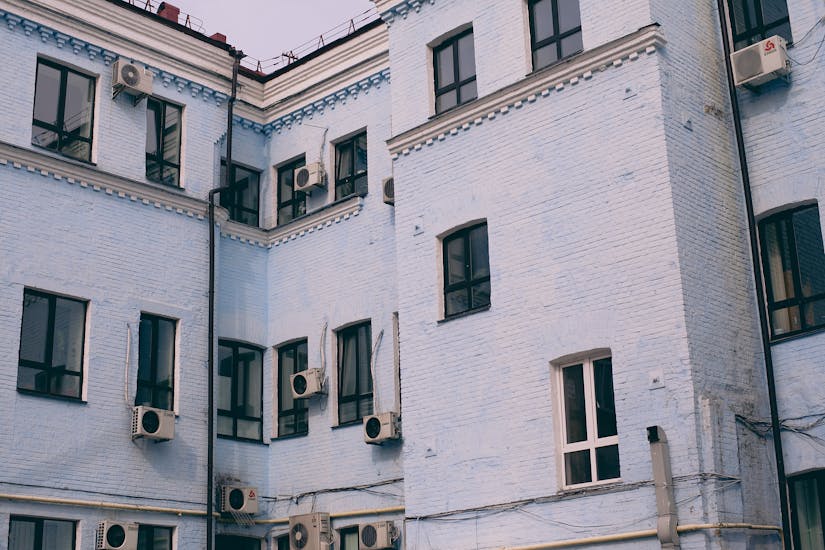The Real Reason Your House Feels Humid Even When the AC Is Running

Is there anything more frustrating than walking into your home after having the air conditioning on all day and feeling like you’ve just walked into a basement? Yes, your thermostat reads a cool 72 degrees. Yet the air is heavy and your skin feels sweaty. Somehow your home just doesn’t feel right. While most people chalk it up to their AC broken or not putting in the work it should, in reality, it’s not that simple.
Understanding why homes are humid even with AC running requires an understanding of how air conditioning works in the first place, what humidity means for comfort levels and how understanding whether something needs attention or whether it’s the wrong expectations is key to a comfortable living space.
How Air Conditioners Humidity
Believe it or not, air conditioners have two jobs, even if most people only think about one. The first job is cooling the air. That’s obvious. But the other job? To remove moisture from the indoor air. Why? Because when warm humid air meets cold evaporator coils inside of your air conditioning unit, that water vapor condenses on the coils, just like your ice-cold lemonade on a hot day results in water beading up on the outside of its cup. As it drips into a pan below, it runs out a drain line and away from your home, along with humidity.
Yet air conditioners aren’t necessarily dehumidifiers. They take humidity away as a byproduct of cooling, not necessarily to cool people’s homes. This is important to note because even an air conditioning system that works well and properly still leaves people feeling uncomfortable because there’s not enough time for moisture removal to occur. Cooling occurs quickly; dehumidification requires time.
Where the System Is Too Big
This is where a lot of people fail to understand their systems and live in homes without realizing it. When an AC system is too big for the space it’s cooling (and more often than you think, this is the case), it cools the entire home so quickly that it works great! Yet it then reaches temperature almost immediately without having the time to eliminate any moisture from the air.
What happens is that an AC system kicks on and blasts cold air for maybe 10 to 15 minutes until it hits its thermostat and then shuts off. It cools temperature, but not humidity, and thus you’re left in a cold, clammy house – but uncomfortable nonetheless. In cases in which cooling capacity does not work well enough for a home’s needs, technicians like Platinum Air Heating & Cooling can perform evaluations to determine if it’s properly sized since to get rid of moisture, AC needs time and efficiency.
For people who think bigger is always better, it’s a common misconception when it comes to these systems. They’re actually better when they’re appropriately sized because then they run longer. That’s good because not only will longer times get to comfortable temperature but they get rid of moisture in the meantime.
When AC Systems Actually Struggle
Sometimes it’s not sizing at all; it’s a problem with systems functioning as they should. A common cause is dirty coils. When evaporator coils – cold ones – are clogged up with dust and grime, they’re not as cold as they should be, meaning there will not be as much condensation which means there will not be water taken out of the air as well.
They’re still making cool air. But at what cost?
Low levels of refrigerant similarly lead to coils that aren’t cold enough. When a refrigerant line leaks somewhere throughout the system, levels drop and coils have the same problem, no condensation but lots of effort burning power while producing some cooler air.
Failing compressors leave homes in that middle ground where they’re not really hot but instead just uncomfortable. The compressor is like the heart of an air conditioning system, without it working well enough, things aren’t getting done well enough.
Ductwork Dilemmas
Ductwork also contributes to problems no one knows about. If ductwork is poorly sealed or insulated, problems arise and result as humidity concerns. If cooled air escapes through holes in ductwork before it gets to living spaces, then systems have to run longer to keep them at temperature. But if humid air exists in non-air conditioned spaces (like attics or crawl spaces), they’re sucked into the same ductwork hoping to get moisture removed. But instead? They’re pumping humidity right into your home.
If ductwork runs through hot attics, condensation can occur. If ducts are not insulated well enough, it makes them cold enough inside that when outside meets hot attic air, condensation builds up on the outside of the ducts. That water runs into insulation, creates mold or leaks into attic space.
How People Use Their Homes Makes It Worse
The way people use their homes complicates these situations more than anyone knows. For example: If someone takes a long hot shower without turning on the exhaust fan, they add gallons worth of moisture into the indoor air. Cooking without ventilation does as well. An average family breaths out moisture; over time, a family of four can contribute several gallons worth of moisture through a house over just one day through normal ventilation (and use) alone.
Keeping windows and doors open for just a moment allows outdoor humid air to flood in. In spaces where outdoor humidity is overwhelming, it won’t just disappear; it will adhere to indoor comforts but now more moisture must be fought against.
House plants add moisture inside as well; so do damp clothes drying indoors. These are all fine in small numbers, but when homes have borderline AC setups, they compound.
What “Normal” Would Be
The sweet spot for humidity inside falls between 30% and 50%. Under 30% it’s too dry (think dry skin and static electricity). Over 60% you’re in the mold realm where mold can grow and people are generally uncomfortable.
Yet here lies the rub: The AC alone can’t keep everyone within normal parameters. People think it should but unless it’s a very humid climate or season, an AC running properly should keep humidity down – but “should” is not synonymous with “does” when people are constantly opening doors, not maintaining systems properly or subjecting their interiors/exteriors to excess moisture-producing opportunities.
When Dehumidification Makes Sense
Dehumidifiers aren’t always about fixing AC systems but adding whole-house dehumidifiers that work alongside them. They’re installed into ductwork and provide dehumidification beyond what any AC system can do, reducing moisture levels more efficiently for those who live in humid climates or whose homes constantly battle moisture levels.
They’re not cheap, though. Sometimes portable dehumidifiers work as well – though they usually treat problem areas better than whole-house scenarios since they need regular emptying (or drain line setup) and can add heat into a room, meaning AC has to work even harder to negate that temperature from rising.
What Happens When Problems Go Unresolved?
High humidity is problematic, not comfortable living or breeding environments for all things mold/mildew. Not to mention that high humidity makes the house feel hotter than it is, which means people turn down thermostats which brings up their electric bills and unnecessary stress.
Dust mites thrive in humid conditions, which means bigger issues for allergies and people living with respiratory conditions.
Wood flooring and furniture swell with excess water; paint and wallpaper peel off walls; books absorb water and become discolored; pages wrinkle; over time, and longer high humidity persist – the more damage occurs.
Solving Humidity Problems
Why does my house feel humid when AC is running? Unfortunately sometimes it’s a process of elimination. People should check basic items – when was the last time they changed their filter? Is their outdoor unit clear? Is their drain line working?
A moisture meter can also help determine if you have actual humidity or perceived humidity, as you can get one for under $20 these days on Amazon. Sometimes when air isn’t super cold but just moving slowly through the house, it feels worse – but by generating air (with fans), then no repairs need to be made!
But if legitimately high humidity accompanies AC running as recommended then troubleshooting professionals make sense – as refrigerant levels being low or duct issues improperly sized could all require technical experience for mitigation.
Generally speaking, when people feel humid despite an AC running like it’s supposed to there’s something that’s wrong, either with how it’s sized, how it’s working or how homes are used, and determining if it’s one of those problems is what helps solve the remedy finally for great comfort.







Comments are closed.